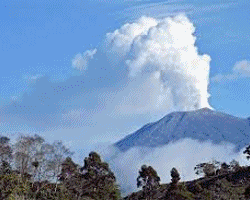At 5,437 feet, the Arenal Volcano looms large and ominous over the pastured green hillsides that surround its base. Although currently in a resting phase, Arenal remained the country’s most active volcano for the past 43 years.

Two hours from San Jose is a tiny town by the name of Zarcero. It's located in the Central Valley of Costa Rica. For some unbeknown reason to everyone, including the people of Zarcero, an older local man, gardener by trade, has made it his mission to create this.

The Turrialba Volcano National Park remains one of the least visited in the entire country. The volcano sits at 10,919 ft (3,328 m) along the southeastend of the Central Volcanic Corridor. Called White Tower (“Torre Alba”) by
the Spanish.

Casa Corcovado Jungle Lodge in Corcovado National Park, is the crown jewel of Costa Rica's world-renowned national park system. It is the last remaining large and sustainable lowland rainforest in Central America.

The Pacuare River, whose headwaters begin on the Atlantic slope in the Talamanca mountain range, runs about 68 miles (108 km) until reaching the Caribbean Sea on the Costa Rica's central coast. This is the quintessential tropical river, with stunning scenery and abounding wildlife . (Class IV Rafting)
“Too many times we stand aside and let the waters slip away, till what we put off till tomorrow has now become today. So don't you sit upon the shoreline and say you're satisfied. Choose to chance the rapids and dare to dance the tide.”
Highland town of ZARCERO, in Alajuela Province, Costa Rica
For some unbeknown reason to everyone, including the people of Zarcero,
a local man and gardener by trade, has made it his mission to create this. Evangelista Blanco Brenes — a dapper man with a mustache, a fedora and
a pair of hedge clippers — created his fanciful garden in 1964.
He has been expanding it for the past 44 years.
That's him - in the picture above.
Costa Rica is one of the most valued environmental destinations in the world. Approximately 25% of the country has protected forests and reserves. There are more than
100 different protected areas to visit.
This one-of-a-kind lodge sits amid exotic primary
rainforest, indigenous reserves and isolated
valleys, and is accessed only by raft.
Famously labeled by National Geographic as ‘the most biologically intense place on earth,’ this national park is the last great original tract of tropical rainforest in Pacific Central America. The bastion of biological diversity is home to Costa Rica’s largest population of scarlet macaws, as well as countless other endangered species, including Baird’s tapir, the giant anteater and the world’s largest bird of prey, the harpy eagle. Corcovado’s amazing biodiversity has long attracted a devoted stream of visitors who descend from Bahía Drake and Puerto Jiménez to explore the remote location and spot a wide array of wildlife.
Sky Tram: 4100 ft (1250 m)
Number of Lines Zip Lines: 7
The longest cable: 2493 ft (760 m)
The highest cable: 656 ft (200 m)
Duration: 2.5 Hour Tour
Located in the Rain Forest
Average Temperature: 82 °F (28 °C)
Wind Speeds: Up to 10 mi/h (16 km/h)
Altitude: 2460 ft (750 m)
(A pioneer Costa Rican family company -
Founded by two brothers and their sister)
Somewhere ages and ages hence:
Two roads diverged in a wood, and I--
I took the one less traveled by,
And that has made all the difference.
- Robert Frost

Supported by buttress roots (stilt roots or prop roots) which are large roots on all sides of a shallowly rooted tree. Typically, they are found in nutrient-poor rainforest soils and do not penetrate to deeper layers. Almost all types of mangroves have these types of roots. They prevent the tree from falling over (hence the name buttress) while also gathering more nutrients. Buttresses are tension elements, being larger on the side away from the stress of asymmetrical canopies. The roots may interwind with buttress roots from other trees and create an intricate mesh, which may help support trees surrounding it. They can grow up to 30 feet (9.1 m) tall and spread for 30 metres above the soil then for another 30 metres below. When the roots spread horizontally, they are able to cover a wider area for collecting nutrients. They stay near the upper soil layer because all the main nutrients are found there.

This is where the journey begins - the rest of the way it is by boat or by foot. They call this kind of airport a 'One Way In and One Way Out'. You approach the landing field into the base of a mountain, so there are no fly arounds or second chances.
You approach and you land - period.
The airport is on the far right of the
landing field on this background image.
Monkeys are one of the most common mammals in Costa Rica – next to bats.
The four common species are the Howler, Spider, White-Faced and Squirrel.
We encountered this monkey on a walk in the Rainforest.
The Arenal Volcano National Park is one of the 10 most active volcanoes in the world.
There are 3 to 20 lava flowing explosions daily sending ash plumes one kilometer above the volcano and boulders down its sides the size of houses.
Set high on a ridge facing Costa Rica's Arenal Volcano, the Arenal Observatory Lodge (below) offers travelers a truly unique experience.
Webpage, Design and All Images Copyright (c) 2016
'If You Don't Like It - TOUGH!' JPG
SOME OF THE PLACES EVERYONE SHOULD VISIT in COSTA RICA